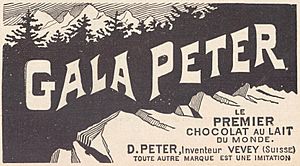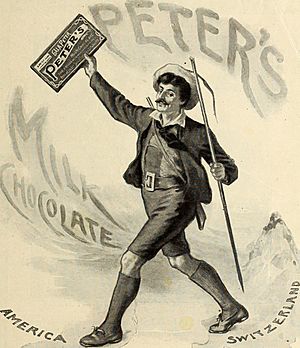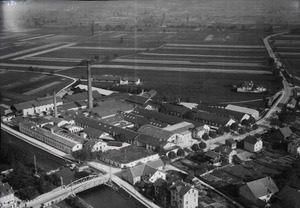Peter's Chocolate facts for kids

Gala peter ad
|
|
| Fate | Mergers:
Acquired by |
|---|---|
| Successor | Brand owned by Cargill & Nestlé since 2002 |
| Founded | 1867 |
| Founder | Daniel Peter |
Peter's Chocolate (also known as Chocolat Peter in French) was a famous Swiss company. It was started in 1867 by Daniel Peter in a town called Vevey. This company is super important because it made the very first successful milk chocolate bar!
Over the years, Peter's Chocolate joined with other companies. It merged with Kohler in 1904. Then, in 1911, it joined with Cailler. Later, in 1929, a big company called Nestlé bought it. In 2002, the Peter's Chocolate brand was bought by Cargill. You might have seen old ads for Peter's Chocolate. They often showed a man in traditional clothes holding a chocolate bar, usually with beautiful mountains in the background.
Contents
The Story of Peter's Chocolate
The Peter's Chocolate company began in 1867. Its founder, Daniel Peter, was a grocer and candle maker. He lived in Vevey, Switzerland. Daniel Peter was also related to François-Louis Cailler. Cailler was another early chocolate maker.
At first, Daniel Peter made candles. But when gas lighting became popular, he focused on chocolate. He bought one of Cailler's factories. This is why his first company was called Peter-Cailler & Cie.
Making the First Milk Chocolate
Daniel Peter had a big goal. He wanted to make a solid version of chocolate milk. This would make it easier to carry and eat. But there was a problem. Chocolate cannot have much water. Too much water makes it lumpy. It also makes it go bad quickly. Earlier tries with fresh milk didn't work well.
Peter found a solution! He used condensed milk from another company. He then dried it even more. This special process is called the milk chocolate crumb process. In 1875, he made a first version of solid milk chocolate.
The final, smooth milk chocolate was ready in 1887. This was thanks to a process called conching. Conching was invented by Lindt in 1879. It makes chocolate very smooth and even. Daniel Peter's new milk chocolate bar was named Gala Peter. The word "Gala" comes from a Greek word meaning 'milk'.
Growing and Merging
The Gala Peter chocolate became very popular. So, a bigger factory was built in Orbe in 1901. Peter's Chocolate also started selling in the United Kingdom that same year.
In 1904, Peter's Chocolate joined with Kohler. They formed a new company called Peter Kohler. Then, in 1911, they merged with Cailler. This created Peter Cailler Kohler.
In 1907, Peter's Chocolate started making chocolate in the United States. They worked with Nestlé in Fulton. By 1911, Peter's milk chocolate recipe was incredibly popular. It made up half of all the chocolate eaten worldwide! Milk chocolate soon became the most common type of chocolate.
Other Products and a Wartime Story
Daniel Peter also created another product in the 1890s. It was called Delta Peter. This was a mix of milk and cocoa powder. You could add it to water to make a chocolate drink. Peter sold it in triangle-shaped packages. Each triangle of pressed powder made one cup of chocolate drink.
During World War II, there was a strange event. Some secret agents tried to use fake Peter's Chocolate bars. These bars looked real on the outside. But inside, they had hidden explosives. The goal was to harm British Prime Minister Winston Churchill. He was known to love sweets. Luckily, a scientist named Lord Victor Rothschild found out. He warned people to watch out for these dangerous fake bars. This helped prevent any harm.
See also



